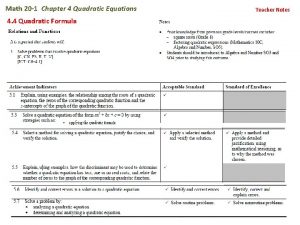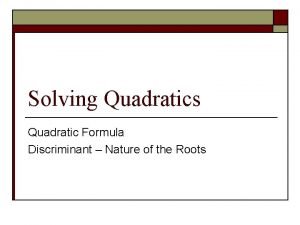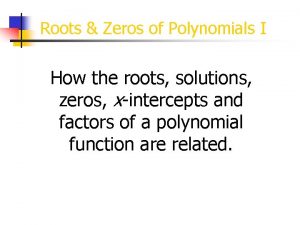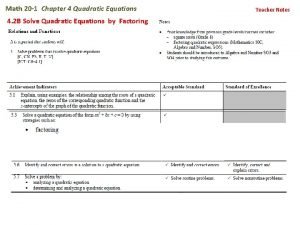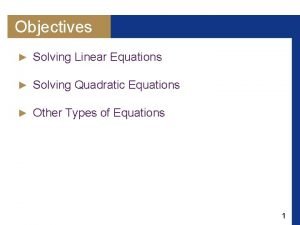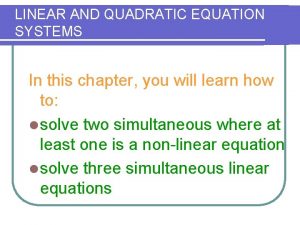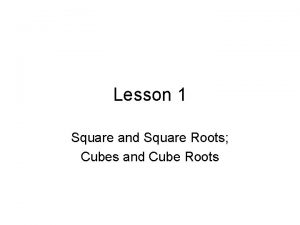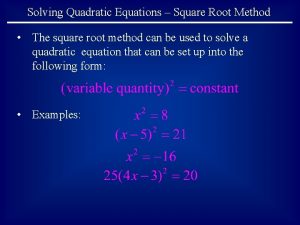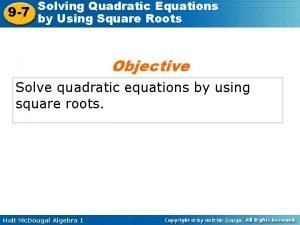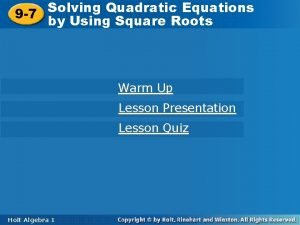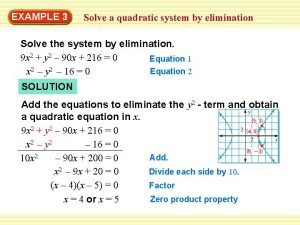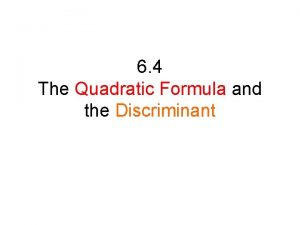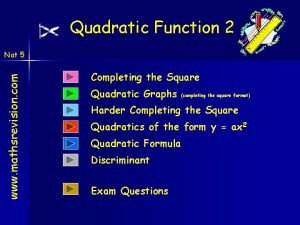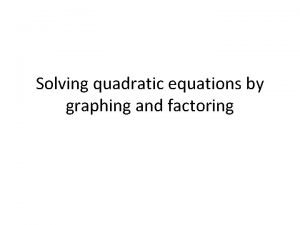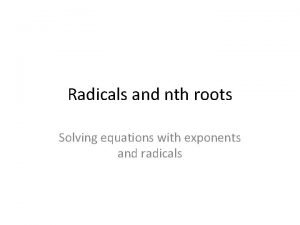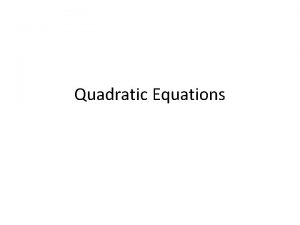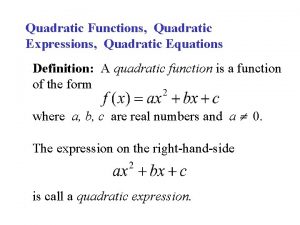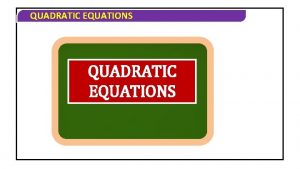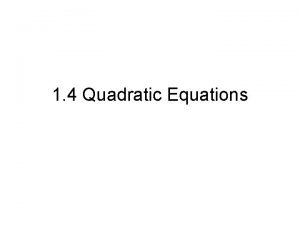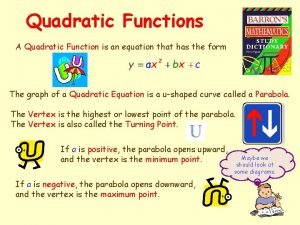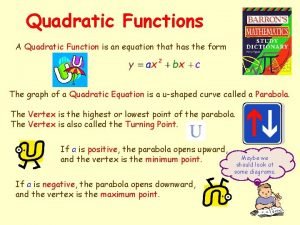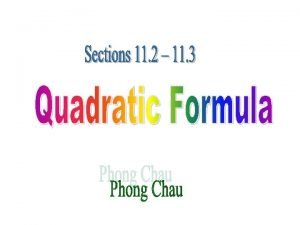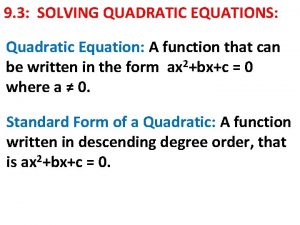Nature of Roots Nature of Roots Quadratic Equation

























- Slides: 25

Nature of Roots

Nature of Roots Quadratic Equation: ax 2 + bx + c = 0 ; a 0 Discriminant = = b 2 – 4 ac >0 Two unequal real roots =0 One double real root (Two equal real roots) <0 No real roots Note: 0 Real roots

Transformation of a graph

Translation The original graph is y = f(x). Let h, k > 0. Graph Transformation Description y = f(x) + k Translation The graph y = f(x) + k is obtained by translating the graph along the y-axis of y = f(x) k units upwards. y = f(x) k Translation The graph y = f(x) k is obtained by translating the graph along the y-axis of y = f(x) k units downwards. y = f(x – h) Translation The graph y = f(x – h) is obtained by translating the graph along the x-axis of y = f(x) h units to the right. y = f(x + h) Translation The graph y = f(x + h) is obtained by translating the graph along the x-axis of y = f(x) h units to the left.

Translation Examples Graph Transformation Description y = f(x) + 3 Translation The graph y = f(x) + 3 is obtained by translating the graph along the y-axis of y = f(x) 3 units upwards. y = f(x) 3 Translation The graph y = f(x) 3 is obtained by translating the graph along the y-axis of y = f(x) 3 units downwards. y = f(x – 2) Translation The graph y = f(x – 2) is obtained by translating the graph along the x-axis of y = f(x) 2 units to the right. y = f(x + 2) Translation The graph y = f(x + 2) is obtained by translating the graph along the x-axis of y = f(x) 2 units to the left.

Reflection The original graph is y = f(x). Graph Transformation Description y = f( x) Reflection about The graph y = f( x) is obtained by reflecting the graph of the y-axis y = f(x) about the y-axis. y = f(x) Reflection about The graph y = f(x) is obtained by reflecting the graph of the x-axis y = f(x) about the x-axis.

Reflection Examples Graph Transformation Description y = 2 x Reflection about The graph y = 2 x is obtained by reflecting the graph of the y-axis y = 2 x about the y-axis. y = 2 x Reflection about The graph y = 2 x is obtained by reflecting the graph of the x-axis y = 2 x about the x-axis.

Enlargement and Reduction The original graph is y = f(x). Graph Transformation Description y = kf(x) , k>1 Enlargement The graph of y = kf(x) is obtained by enlarging to k times along the y-axis the graph of y = f(x) along the y-axis. y = kf(x) , k<1 Reduction along The graph of y = kf(x) is obtained by reducing to k of the y-axis graph of y = f(x) along the y-axis. y = f(kx) , k>1 Reduction along The graph of y = f(kx) is obtained by reducing to 1/k of the x-axis the graph of y = f(x) along the x-axis. y = f(kx) , k<1 Enlargement The graph of y = f(kx) is obtained by enlarging to 1/k along the x-axis times of the graph of y = f(x) along the x-axis.

Enlargement and Reduction Examples Graph Transformation Description y = 2 f(x) Enlargement The graph of y = 2 f(x) is obtained by enlarging to 2 times along the y-axis the graph of y = f(x) along the y-axis. y = f(x) Reduction along The graph of y = f(x) is obtained by reducing to 1/2 of the y-axis the graph of y = f(x) along the y-axis. y = f(2 x) Reduction along The graph of y = f(2 x) is obtained by reducing to 1/2 of the x-axis the graph of y = f(x) along the x-axis. y = f( x) Enlargement The graph of y = f( x) is obtained by enlarging to 2 times along the x-axis of the graph of y = f(x) along the x-axis.

Trigonometric Functions

Trigonometric Functions of Special Angles (I) 0 sin 30 45 0 60 90 1 30 2 2 60 cos 1 tan 0 0 1 1 undefined 1 45 1

Trigonometric Functions of Special Angles (II) (0, 1) ( 1, 0) (0, 1) 1 0 sin 1 0 0 1 cos 0 undefined 1 0 tan undefined 0

Trigonometric Functions of General Angles (I) S T II I III IV A C

Trigonometric Functions of General Angles (II) 90 180 + 360 + sin cos sin cos sin cos tan tan

Nets of a cube

Nets of a cube Two nets are identical if one can be obtained from the other from rotation (turn it round) or/and reflection (turn it over). An example of identical nets.

Nets of a cube There a total of 11 different nets of a cube as shown.

Planes of Reflection

Planes of Reflection of a Cube

Planes of Reflection of a Regular Tetrahedron

Axes of Rotation

Axes of Rotation of a Cube order of rotational symmetry = 4 order of rotational symmetry = 3 order of rotational symmetry = 2

Axes of Rotation of a Regular Tetrahedron order of rotational symmetry = 3 order of rotational symmetry = 2

Compare Slopes of Different Lines

undefined slope m 1 < m 2 < m 3 < m 4 < m 5 < m 6 < m 7 > 1 m 6 = 1 ( = 45 ) 0 < m 5 < 1 m 4 = 0 1 < m 3 < 0 m 2 = 1 ( = 135 ) m 1 < 1 x
 Nature of roots graph
Nature of roots graph Real roots
Real roots What's the quadratic formula
What's the quadratic formula How do you find roots
How do you find roots Quadratic equation
Quadratic equation Linear equation and quadratic equation
Linear equation and quadratic equation Solving systems of linear and quadratic equations
Solving systems of linear and quadratic equations Vanessa jason biology roots
Vanessa jason biology roots Perfect squares
Perfect squares Lesson 3 existence and uniqueness
Lesson 3 existence and uniqueness The roots of american imperialism economic roots
The roots of american imperialism economic roots Perfect cubes list
Perfect cubes list How to solve quadratic equations by square roots
How to solve quadratic equations by square roots 9-7 solving quadratic equations by using square roots
9-7 solving quadratic equations by using square roots Solving quadratics
Solving quadratics Quadratic graphs roots and turning points
Quadratic graphs roots and turning points Factorise quadratic equations
Factorise quadratic equations 9-7 solving quadratic equations by using square roots
9-7 solving quadratic equations by using square roots 9-7 solving quadratic equations by using square roots
9-7 solving quadratic equations by using square roots How to solve quadratic equations by elimination
How to solve quadratic equations by elimination Discriminant and nature of roots
Discriminant and nature of roots Discriminant formula
Discriminant formula Completing the square nat 5
Completing the square nat 5 Roots of nature
Roots of nature Solve by factoring x^2-9=0
Solve by factoring x^2-9=0 Rational exponent notation
Rational exponent notation

